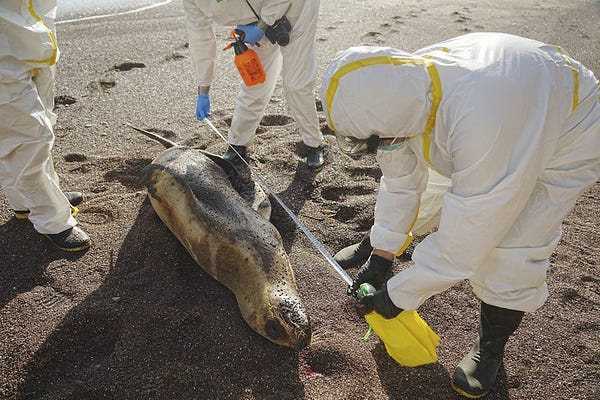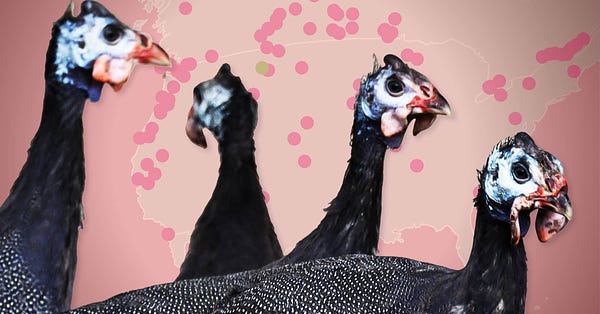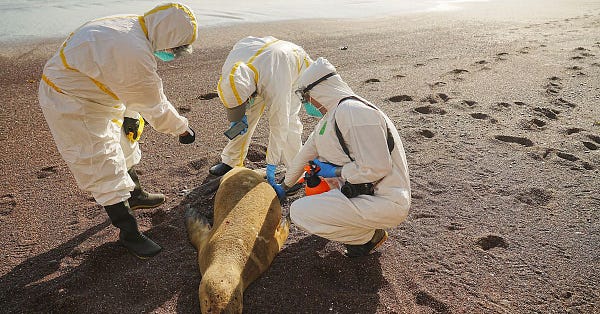When COVID came to the United States we had a chance to demonstrate the effectiveness of our planning for handling just such a pandemic. It was advanced. At the appropriate levels, the procedures to be followed were well known and agreed upon.
Instead of following those procedures, however, we abandoned them. We adopted Chinese-style lockdowns and bet everything on experimental vaccines. We did everything wrong.
In the three years since we have incorporated none of the lessons learned. Our planning is still dominated by the inerests of Big Pharma and the need to make money off of suffering. If another pandemic hits tomorrow, we will apparently repeat all our previous mistakes.
And, this time the disease that strikes may be far, far worse.


Hundreds of dead sea lions have been washing up on the beach in Peru since January. Researchers have confirmed that the animals died of the A(H5N1) bird flu virus, which has now jumped from seabirds to mammals. Indications are also that the virus is not just spreading from birds to mammals.
It is spreading from mammal to mammal directly.
In one incident in January at least one hundred sea lions were found dead floating in the same area off the coast of Peru. It seems highly unlikely that every one of these animals just happened to have eaten an infected seabird. It seems much more likely that they passed the disease to each other.
Dutch veterinarian Thijs Kuiken, an expert on emerging diseases, noted recently that direct mammal-to-mammal transmission now seems likely. “Given the large number of specimens found dead, it seems more likely that there was direct transmission between sea lions,” says Kuiken, from the Erasmus University Medical Center in Rotterdam. “It’s worrying,” he continued. “This is the second mass mortality episode to suggest that this virus can readily adapt to efficient mammal-to-mammal transmission. If it can occur in mink and sea lions, why wouldn’t it happen in humans?”
Kuiken’s comments about minks were a reference to a separate incident involving the mass death of minks at a mink farm in Spain. A study led by Montserrat Agüero, from the Spanish Ministry of Agriculture’s Central Veterinary Laboratory, suggested that the avian virus mutated at the mink farm and was then transmitted from mammal to mammal. That outbreak alarmed scientists worldwide with British doctor Jeremy Farrar, newly appointed scientific director of the World Health Organization (WHO), warning on social media of the risk of “a devastating flu pandemic.”


A report about the incident published in October 2022 concluded that the number of infected animals and the way the spread occurred “indicate that an onward transmission of the virus to other minks may have taken place.” The report researchers also noted that the viral strain found among the farmed weasels carried mutations, some of which could potentially make the disease more transmissible between a wider array of species.
Minks have very similar respiratory tracts to humans. Among animals, they’re considered a likely vector point for new and emerging diseases. Already, we’ve seen this with covid-19. One 2021 study concluded that that weasels could be a “highly susceptible host species,” of avian influenza, specifically.
The A(H5N1) virus circulating around the world is devastating in its lethality. In Europe alone, it has forced farmers to kill off more than 50 million infected poultry. In Peru, the virus has killed at least 50,000 wild birds. The virus has also previously infected humans, but always as far as is known when those humans had extended direct contact with infected birds. It has never previously, as far as we know, moved directly from mammal to mammal.
It appears to have learned how.
In fact, all over the world, we are beginning to see signs that the avian flu is now increasingly infecting and killing mammals. Grizzly bears have died in Montana. Foxes and otters have been killed in the United Kingdom.
As yet there is no documented case of human-to-human transmission of the virus. There is every reason to think, however, that the virus will continue to evolve. There is also a dangerous precedent for what an avian flu virus can do.
The human Spanish flu pandemic is believed to have been triggered by a successful transmission of an avian flu virus to humans. That pandemic killed 50 million people.
“The initial strain then adapted and became endemic in the human population, giving rise to the seasonal flu viruses,” said Professor Massimo Palmarini, director of the Centre for Virus Research, Glasgow University in discussing the danger now posed by H5N1.


Whatever happens with this latest form of the avian flu, what is certain is that future pandemics will occur and they are likely to involve diseases far more lethal than COVID. We cannot continue to indulge the Big Pharma-financed fantasy that lockdowns and “vaccines” will save us. We need to take a hard look at how we handled this last pandemic, learn the necessary lessons, hold those who led us astray accountable, and get our ship in order.
Today sea lions are dying. Tomorrow it may be us.




What I learned from Covid is. 1. I cannot control what is out there. 2. I can control how I deal with it. 3. I don’t trust a word from so called experts. 4. Big Parma is only concerned with $. 5. Government is only concerned with $ (donations) and power. 6. Everyone lies for $. Back to trusting in God, reading His word, praying and living as healthy as I can. In time this panic will pass.
“National University of San Marcos pathology tests confirm presence of H5N1 virus in 585 dead sea lions.”
I no longer believe, 100% what I’m told. This is something I learned over the past three years. Are we able to verify these pathology reports? After all, we have yet to see the Covid 19 virus for some reason.